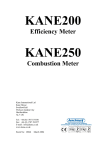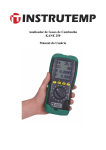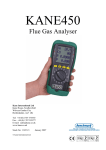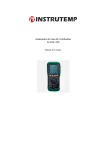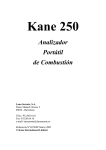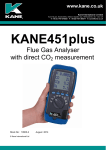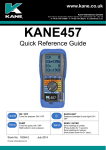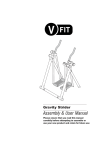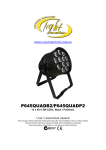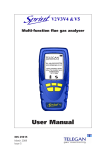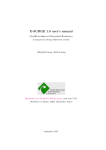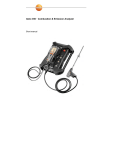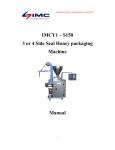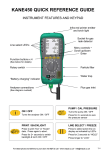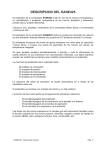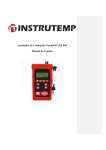Download Kane 250 combustion flue gas analyser user manual
Transcript
KANE200 Efficiency Meter KANE250 Combustion Meter Kane International Ltd Kane House Swallowfield Welwyn Garden City Hertfordshire AL7 1JG Tel: +44 (0) 1707 375550 Fax: +44 (0) 1707 393277 E-mail: [email protected] www.kane.co.uk Stock No: 18046-3 November 2008 CONTENTS Page No: KANE200 and KANE250 User Guide .............................................................................1 1. BEFORE USING THE METER FOR THE FIRST TIME ....................................2 2. BEFORE USING THE METER EVERY TIME ....................................................3 3. USING THE METER AND ITS FOUR BUTTONS.......................................... 4-5 4. USING THE ROTARY DIAL (STARTING FROM MENU) ........................... 6-8 5. MEASURING FLUE GASES........................................................................... 9-11 6. WHEN YOU FINISH USING THE METER .......................................................12 7. METER PROBLEM SOLVING ...........................................................................12 8. METER ANNUAL RECALIBRATION AND SERVICE ...................................13 9. METER SPECIFICATION (NOTE MAY BE SUBJECT TO CHANGE) ..........14 10. ELECTROMAGNETIC COMPATIBILITY........................................................15 APPENDIX 1 – MAIN PARAMETERS............................................................... 16-17 KANE200 & KANE250 User Guide The KANE200 Efficiency Meter tests heating appliances for O2, CO2, temperature and combustion efficiency. The KANE250 Combustion Meter measures O2, temperature and CO and then calculates efficiency (Nett, Gross or Condensing), the CO/CO2 ratio and Poison Index In addition the KANE250 Combustion Meter’s CO sensor checks CO levels in ambient air - useful when a CO Alarm is triggered .. and tests the safety of appliances. It also calculates CO air free in ppm only. The CO reading can be referenced to the oxygen reading in ppm or mg/m3. All meters have a protective rubber sleeve with a magnet for “hands– free” operation and their flue probes work on all combustion appliances and take ambient air measurements. The large display shows 2 readings at a time and all data can be printed via an optional infrared printer. The printed data can be 'live' data, 'frozen data' or stored data. 16 sets of tests can be stored. Note: stored data is lost if the batteries are removed or are exhausted. Two lines of 16 characters can be added to the header of printouts. The meters are controlled using 4 buttons and a rotary dial. The four buttons (from left to right) switch on and off the meter, print actual or frozen data, switch on and off the backlight, switch on and off the pump and “freeze” or hold data. If the HOLD button is pressed for more than 2 seconds the current data is stored in memory and the test number is briefly displayed. The buttons with UP, DOWN and ENTER arrows also change settings such as date, time, fuel source, and the display’s top line. The rotary dial changes the display’s 2nd line and selects access to the menu to make changes to the date, time, fuel, etc. 1 KANE200 series manual 1. BEFORE USING THE METER FOR THE FIRST TIME: Turn over the meter, remove its’ protective rubber sleeve and fit 4 “AA” batteries in the battery compartment. Take great care to ensure they are fitted with the correct battery polarity. Then replace the battery cover and protective rubber sleeve. Always check that the meter is working correctly after replacing batteries. Set the meter’s correct time, date, fuel source, etc, after it is switched on and calibrated – See USING THE ROTARY DIAL below. These are stored when the meter is switched off. Using Re-Chargeable Batteries. This meter has been designed for use with both alkaline and rechargeable Nickel Metal Hydride (NMiH). No other battery types are recommended. WARNING The battery charger unit must only be used when NMiH batteries are fitted. Alkaline batteries are not re-chargeable. Attempting to recharge Alkaline batteries may result in damage to the product and may create a fire risk. Charging Ensure that you use the correct charger. The part number is KMCU250/UK. Ensure the batteries are fitted in the correct manner then on first charging, charge for at least 16 hours continuously, subsequently charge overnight. NMiH batteries are entirely suitable for top up charging at any time, even for shorts periods. An in-vehicle adapter can be used to top up the meter's batteries from a 12 volt vehicle battery. The part number is KM12/12 Battery Disposal Always dispose of depleted batteries using approved disposal methods that protect the environment 2 KANE200 series manual 2. BEFORE USING THE METER EVERY TIME: Check the water trap is empty and the particle filter is not dirty: - To empty water trap, unplug its rubber stopper and re-plug once it is empty. - To change the filter, remove protective rubber sleeve, pull out the water trap unit from the meter, remove the water trap’s particle filter from its’ spigot and replace. Reconnect the water trap and rubber protective sleeve. Connect the flue probe into the bottom of the meter’s water trap and connect the probe’s temperature plug to the socket next to the water trap – check the plug’s orientation is correct otherwise incorrect temperature measurements will occur. After switch on, check fuel source, date and time are correct and battery power is sufficient. SAFETY WARNING This meter extracts combustion gases that may be toxic in relatively low concentrations. These gases are exhausted from the back of the instrument. This meter must only be used in well-ventilated locations by trained and competent persons after due consideration of all the potential hazards. Sensor manufacturers recommend users of portable gas detectors containing electrochemical conduct a “bump” check before relying on the unit to verify an atmosphere is free from hazard. A “bump” test is a means of verifying that an instrument is working within acceptable limits by briefly exposing to a known gas mixture formulated to change the output of all the sensors present. (This is different from a calibration where the instrument is also exposed to a known gas mixture but is allowed to settle to a steady figure and the reading adjusted to the stated gas concentration of the test gas). For Oxygen monitors a level of confidence that the unit is working adequately may be gained by exhaling over the sensor inlet and viewing the reduction in reading obtained. 3 KANE200 series manual 3. USING THE METER AND ITS FOUR BUTTONS: Switching ON the Meter Press button to switch the unit ON in fresh air outside the property about to be tested. This lets the meter auto calibrate its’ sensors properly. On switch on, the meter beeps four times and displays on its’ top line the fuel previously selected, the date and time and model number. Its’ bottom line counts down from 60 until the sensors are ready to use – This normally takes 20 - 30 seconds but may take longer as sensors get older. If the meter will not auto calibrate, its’ sensors need to be replaced or recalibrated by an authorized repair center. If you connect the flue probe’s temperature plug to the meter during its’ countdown the measured temperature will be used as the inlet temperature. If you do not connect the flue probe’s temperature plug during countdown the meter’s ambient temperature will be used as the inlet temperature. When countdown is finished the display’s top line shows the last selected function and the bottom line displays whatever the rotary dial is turned to. Switching OFF the Meter Press button to switch the meter OFF. The display counts down from 30 with the pump on to clean the sensors with fresh air – If the probe is still connected, make sure meter and probe are in fresh air. Press HOLD / ENTER if you want to stop the countdown and return to making measurements. Note: the meter will not switch off until the CO reading is below 20ppm Using UP / DOWN / ENTER Buttons Press for more than 1 second the DOWN button to change the display’s top line. The Rotary Dial changes the display’s bottom line. For example, the meter will display CO2 on its’ top line and Efficiency on its’ bottom line if you turn the rotary dial to EFF and push the DOWN button until CO2 is displayed on the top line. Use the UP / DOWN / ENTER keys to change settings (such as time, date and fuel) when the rotary dial is turned to MENU. 4 KANE200 series manual Switching on and off the backlight. Press and release PRINT / BACKLIGHT quickly to switch backlight on or off. Printing Data Press for more than 1 second before releasing to start the meter printing. The meter displays "PRINTING" until this is completed. Make sure the printer is switched on, ready to accept data and its’ infrared receiver is in line with the meter’s emitter (on top of the meter). Switching PUMP on / off The meter normally operates with the pump on. Press PUMP quickly to switch the pump off and on. When the pump is switched off, the meter displays "PUMP OFF" approx every 30 seconds. NOTE: the pump will not switch off if the CO reading is above 20ppm . This helps to protect the CO sensor from damage. “Freezing” the display Press HOLD / ENTER to freeze all readings. The display flashes and can be printed by pressing PRINT key. Press HOLD / ENTER again for “live” measurements. Press HOLD/ENTER for more than 2 seconds to store data in memory. Showing CO air free readings (not KANE200) 5 Press DOWN to scroll round the top line until COa is displayed with its’ reading. KANE200 series manual 4. USING THE ROTARY DIAL (starting from Menu): Rotating the dial selects the display’s 2nd line, unless MENU is selected. MENU Rotate the dial to MENU and use the UP or DOWN buttons to select the following function for change: 1 Time – Uses “Military” time as standard: 7am = 07:00, 7pm = 19:00 2 Date 3 The display’s top line – select from the settings listed below 4 Temperature units - oF or oC 5 The display’s contrast 6 Boiler / Furnace fuel supply – select from fuels 7 Language 8 Header – 2 lines each of up to 16 characters that appear on the printout. Use ENTER and UP/DOWN. 9 Store- save up to 16 sets of test results. LOG saves a set of results when ENTER is pressed DEL ALL clears all the memory when YES and ENTER pressed. NOTE. ENTER must be pressed to exit this mode. VIEW: the test number appears on the top line. The dial position displays the stored values. Use UP or DOWN to change test number. Use ENTER to exit this mode. 10 O2 reference can be set between 0 and 20% 11 Gross or Net or Condensing Boiler / Furnace efficiency 12 ppm or mg/m3 14 Service – Password protected for service personnel only When you have selected the function to change, press ENTER to select. Repeat this to scroll through the menu and select (using the ENTER key) and change (using the UP / DOWN keys) the function. The final, logical ENTER returns you to the main menu display. To exit the Menu function you can normally rotate the dial to another position - Unless the final logical ENTER is pressed, no changes are made. 6 KANE200 series manual The exception is STORE DELETE where the ENTER key must be pressed to confirm the change and exit. If you rotate the dial before pressing ENTER the instrument will beep continuously. You must rotate the dial back to MENU and press ENTER before you can continue. In STORE View mode the rotary dial is used to select the saved parameter to be displayed. Use the UP/DOWN keys to change the Test number. To exit the View mode press ENTER. TOP LINE OPTIONS * not KANE200 7 Time Date CO2 O2 T nett T flue Efficiency Excess Air *CO Battery Status Fuel *CO/CO2 ratio *Poison Index Ambient Temp *CO air free Losses O2 Reference value KANE200 series manual ROTARY DIAL POSITIONS TIME Displays Time DATE Displays Date CO2 Displays calculated Carbon Dioxide values once O2 values are below 18%. O2 Displays Oxygen values in %. T Nett Displays the difference between flue and inlet / ambient temperatures. If the flue probe’s temperature sensor is broken or open circuit it displays - - - -. T Flue Displays flue (or inlet) temperatures in oF or oC . If the flue probe’s temperature sensor is broken or open circuit it displays - - - -. EFF Displays calculated efficiency when O2 values are less than 18% EFFn, EFFg or EFFc as selected by the user. X AIR Displays calculated excess air when O2 values are less than 18%. Loss Displays calculated losses when O2 values are less than 18% (KANE200 only) CO (not KANE200) Displays Carbon Monoxide values in PPM as CO in ppm normalized ac COn Display value in mg/m3 as COm in mg/m3 normalised as COĦ BAT Displays estimated battery life. If battery voltage falls below a pre-set limit, the display flashes "LOW BAT." every 10 seconds. See above to change the batteries or use the optional mains adaptor Fuel 8 Displays boiler / furnace fuel selected KANE200 series manual 5. MEASURING FLUE GASES After the countdown is finished and the meter is correctly set up, put its’ flue probe into the appliance’s sampling point. The ideal sampling point is at least two flue diameters downstream of any bend. Put the probe tip in the flue center. With balanced flues, make sure the probe is positioned far enough into the flue so no air can ‘back flush’ into the probe. Use the probe’s depth stop cone to fix it in flue diameters from 1/4 to 4/5 inch, 6 to 21 mm. Its maximum operating temperature is 1112°F / 600°C. Make sure you do not exceed the meter’s operating specifications. In particular: • • • • • Do not exceed the flue probe’s maximum temperature Do not exceed the meter’s internal temperature operating range Do not put the meter on a hot surface Do not exceed the water trap’s levels Do not let the meter’s particle filter become dirty and blocked View data and rotate the dial to see flue changes as you make adjustments. Press PRINT. Press HOLD first to “freeze” or store the readings before printing 9 KANE200 series manual EXAMPLE PRINTOUT IN AMBIENT AIR The standard printouts are: KANE200 -16 char.header 16 char.header Date: 26 / 12 /02 Time: 14:27:08 …………………………….. Fuel NATU GAS O2 % CO2 % NETT . AMB FLUE . EFF% (G) LOSSES XAIR 10 KANE200 series manual 20.9 0.0 C C C % % ------------------------- NOTE: Printouts of stored readings will also include the TEST NO. below the header. KANE250 -- 16 char. Header 16 char. header Date: Time: 12 / 26 /02 14:27:08 …………………………….. EFF % (G) = gross EFF % (N) = nett EFF % (C) = condensing Fuel O2 CO2 CO CO a NATU GAS % % ppm ppm NETT . AMB FLUE . EFF% (G) LOSSES XAIR CO/CO2 PI % O2 ref % 20.9 0.0 00 00 C C C % % --------------------------------- SMOKE……………………. ……………………………… 11 KANE200 series manual 6. WHEN YOU FINISH USING THE METER Remove its’ probe from the flue - THE PROBE WILL BE HOT - and let it cool. Do not put the probe in water which will be sucked into the meter, damaging its’ pump and sensors. When the meter’s readings return to ambient levels, switch it off. The meter counts down from 30 before switch off with the pump running to self clean its sensors. 7. METER PROBLEM SOLVING If any problems are not solved with these solutions, contact us or an authorized repair center. Fault symptom Causes / Solutions • Oxygen too high • Air leaking into probe, tubing, water trap, connectors or internal to meter. • CO2 too low • Oxygen cell needs replacing. • Oxygen reading (- - - -) • Meter was stored in a cold environment and is not at normal working temperature. • CO reading (- - - -) • Oxygen cell or CO sensor needs replacing. • Pump is switched off • Batteries not holding charge • Batteries exhausted. • Meter not running on mains adapter. • AC charger not giving correct output. • Meter does not respond to flue gas • Particle filter blocked. • Fuse blown in charger plug. • Probe or tubing blocked. • Pump not working or damaged with contaminants. • Net temperature or Efficiency calculation incorrect. • Ambient temperature set wrong during Automatic Calibration. • Flue temperature readings erratic • Temperature plug reversed in socket. • Faulty connection or break in cable or plug. • T flue or T nett displays (- - - -) • Probe not connected. • X-Air, EFF, COa or CO2 display (- - - -) • Oxygen reading is above 18% • Meter just continually beeps • Turn dial back to MENU and press ENTER 12 KANE200 series manual 8. METER ANNUAL RECALIBRATION AND SERVICE Although sensor life is typically more than two years, the meter should be recalibrated and serviced annually to stop any long-term sensor or electronics drift or accidental damage. Local regulations may require more frequent re-calibration. 13 KANE200 series manual 9. METER SPECIFICATION (NOTE MAY BE SUBJECT TO CHANGE) Parameter Resolution Accuracy Range Flue Temperature 1.0°C/F +2.0°C (5°F) +0.3% reading 0-600°C 32-1112°F Inlet Temperature 1°C/F +1°C/F ±0.3% reading 0-100°C 32-212°F Temp (Nett) *2 1.0°C/F +2°C (5°F) +0.3% reading 0-600°C 32-1112°F Gas Measurement Oxygen 0.1% +0.2%*1 0-21% *Carbon Monoxide 1ppm +10ppm <100ppm*1 +5% of reading 0-1000ppm 0.1% 0.1% 0.1% +0.3% reading +1.0% reading +0.2% 0-30% 0-99.9% 0-250% Temp Measurement (not KANE200) Carbon Dioxide*2 Efficiency*2 Excess Air*2 Pre-programmed Fuels Dimensions Weight Handset Probe KANE250: Natural gas, Light Oil, Propane, Butane, LPG, Wood Pellets. KANE200: as above plus heavy oil, coal, anthracite 1kg / 2.2lb 200mm / 7.9” x 45mm / 1.8” x 90mm / 3.5” L300mm / 11.8” x Dia 6mm / 0.25”with 200mm / 7.8” long stainless steel shaft, type K thermocouple and 3m / 6ft long neoprene hose Ambient Operating Range +0°C to +40°C / 32-104°F 10% to 90% RH non- condensing Storage Capacity 16 sets of test results in volatile memory Battery Life 4 AA cells >8 hours using Alkaline AA cells AC battery charger (optional) Input: 110Vac/220 Vac nominal Output: 10 Vac off load *1 14 Using dry gases at STP *2 Calculated KANE200 series manual 10. ELECTROMAGNETIC COMPATIBILITY European Council Directive 89/336/EEC requires electronic equipment not to generate electromagnetic disturbances exceeding defined levels and have adequate immunity levels for normal operation. Specific standards applicable to this meter are stated below. As there are electrical products in use pre-dating this Directive, they may emit excess electromagnetic radiation levels and, occasionally, it may be appropriate to check the meter before use by: Use the normal start up sequence in the location where the meter will be used. Switch on all localized electrical equipment capable of causing interference. Check all readings are as expected. A level of disturbance is acceptable. If not acceptable, adjust the meter’s position to minimize interference or switch off, if possible, the offending equipment during your test. At the time of writing this manual (Dec 2002) Kane International Ltd are not aware of any field based situation where such interference has occurred and this advice is only given to satisfy the requirements of the Directive. This product has been tested for compliance with the following generic standards: EN 61000-6-3 EN 61000-6-1 and is certified to be compliant Specification EC/EMC/KI/K200S details the specific test configuration, performance and conditions of use. Please Note: Batteries used in this instrument should be disposed of in accordance with current legislation and local guidelines. 15 KANE200 series manual Appendix 1 - Main Parameters: Here are the legends used and what they mean: O2 : Oxygen reading in percentage (%) O2R: Oxygen reference setting. '----' means switched off or set to 0%. T Flue: Temperature measured by the flue gas probe in Centigrade or Fahrenheit. It displays ‘- - -’ if the flue probe is disconnected. T Nett : Nett temperature calculated by deducting the AMBIENT or INLET temperature from the measured FLUE temperature. Displays in either Fahrenheit (°F) or Centigrade (°C) or and will display ‘- - -’ if the flue probe is not connected. CO: C0m: Carbon Monoxide reading displayed in ppm (parts per million). ‘- -’ is displayed if there is a fault with the CO sensor or the instrument has not set to zero correctly, switch off instrument and try again. Carbon Monoxide displayed in mg/m3. COn: Carbon Monoxide in ppm normalised to the O2R value COĦ: Carbon Monoxide in mg/m3 normalised to the O2R value. COa Carbon Monoxide calculation as if there were 0% Oxygen present. This is only displayed in ppm CO2 : Carbon Dioxide calculation determined by fuel type. This is only displayed when a combustion test is being carried out. ‘- - -’ is displayed while in fresh air. EFF : Combustion efficiency calculation displayed in percentage either as Gross (G) or Nett (N) or Condensing Nett (C) - Use MENU to change. The calculation is determined by fuel type and uses the calculation in British Standard BS845. The efficiency is displayed during a combustion test, ‘- - - -’ is displayed while in fresh air. X - AIR : Excess air calculated from the measured oxygen and type of fuel used. Displays reading during a combustion test. ‘- - - -’ is displayed while in fresh air. Loss : Losses calculated from Oxygen and type of fuel. Displays reading during a combustion test. ‘- - - -’ is displayed while in fresh air. 16 KANE200 series manual 18 KANE200 series manual Thank you for buying this instrument. Before use, please register on our website www.kane.co.uk 20 KANE200 series manual




















